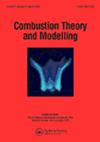Enhanced reactivity by energy trapping in shocked materials: reactive metamaterials for controllable output
IF 1.6
4区 工程技术
Q4 ENERGY & FUELS
引用次数: 2
Abstract
Through the use of carefully designed numerical experiments on an explosive system, that use predictive models for subcomponents and multi-material simulation, we demonstrate enhanced reactivity by energy trapping in regions of the reactive flow that were previously shocked. Particles and inclusions are placed in designed patterns in an explosive matrix. New capabilities in additive manufacture make it possible to consider novel designs, that we refer to as ‘reactive metamaterials’. For a fixed amount of energy delivered by a shock impactor, an explosive that normally would not detonate, will detonate when particles are included. Enhanced reactivity correlates precisely with a change in the partition of energy from kinetic to internal, via reflective processes and flow stagnation in high pressure systems. We analyse cases associated with high shock impedance tantalum particles, and void inclusions, individually and placed in a test array. High impedance reflectors trap energy in regions of pre-shocked material. Whereas void shock collapse causes depressurisation of the material along with rapid material flow, and high pressure spot formation related to the jet impact blast. We analyse how these limiting cases of high impedance particle arrays and void arrays partition specific kinetic and internal energy, during the shock impact transient on the system of matrix explosive and embedded particle/voids. Both generate specific flow fields, pressure and temperature cycles in the matrix material over interval times, determined by the particle/void size and placement. Design variations of the configurations presented here can be tested by both experiment and simulation, and can be searched for optimal designs, aided by modern machine learning search methods.通过冲击材料中的能量捕获增强反应性:用于可控输出的反应超材料
通过在爆炸系统上使用精心设计的数值实验,使用子组件和多材料模拟的预测模型,我们证明了通过在先前受到冲击的反应流区域捕获能量来增强反应性。颗粒和夹杂物在爆炸基质中按设计的模式放置。增材制造的新功能使得考虑新颖的设计成为可能,我们称之为“反应性超材料”。对于由冲击器传递的固定能量,通常不会爆炸的炸药在包含颗粒时将会爆炸。反应性的增强与高压系统中通过反射过程和流动停滞从动能到内部能量分配的变化密切相关。我们分析了与高冲击阻抗钽颗粒和空洞内含物相关的案例,分别放置在测试阵列中。高阻抗反射器在预冲击材料区域捕获能量。而空洞冲击塌陷导致材料的降压,伴随着材料的快速流动,以及与射流冲击爆炸有关的高压斑的形成。我们分析了高阻抗粒子阵列和空隙阵列在基体炸药和嵌入粒子/空隙系统的瞬态冲击冲击过程中如何分配比动能和内能的极限情况。两者在间隔时间内都会在基体材料中产生特定的流场、压力和温度循环,这取决于颗粒/空隙的大小和位置。在现代机器学习搜索方法的帮助下,可以通过实验和模拟来测试配置的设计变化,并可以搜索最佳设计。
本文章由计算机程序翻译,如有差异,请以英文原文为准。
求助全文
约1分钟内获得全文
求助全文
来源期刊

Combustion Theory and Modelling
工程技术-工程:化工
CiteScore
3.00
自引率
7.70%
发文量
38
审稿时长
6 months
期刊介绍:
Combustion Theory and Modelling is a leading international journal devoted to the application of mathematical modelling, numerical simulation and experimental techniques to the study of combustion. Articles can cover a wide range of topics, such as: premixed laminar flames, laminar diffusion flames, turbulent combustion, fires, chemical kinetics, pollutant formation, microgravity, materials synthesis, chemical vapour deposition, catalysis, droplet and spray combustion, detonation dynamics, thermal explosions, ignition, energetic materials and propellants, burners and engine combustion. A diverse spectrum of mathematical methods may also be used, including large scale numerical simulation, hybrid computational schemes, front tracking, adaptive mesh refinement, optimized parallel computation, asymptotic methods and singular perturbation techniques, bifurcation theory, optimization methods, dynamical systems theory, cellular automata and discrete methods and probabilistic and statistical methods. Experimental studies that employ intrusive or nonintrusive diagnostics and are published in the Journal should be closely related to theoretical issues, by highlighting fundamental theoretical questions or by providing a sound basis for comparison with theory.
 求助内容:
求助内容: 应助结果提醒方式:
应助结果提醒方式:


